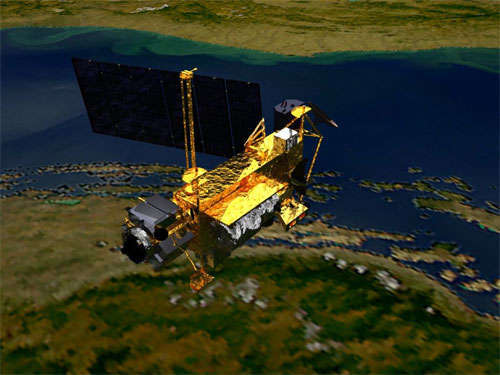
The Sky is Falling As Satellite Drops In... Maybe on Ketchikan
September 14, 2011
NASA's UARS, Upper Atmosphere Research Satellite, is expected to re-enter Earth's atmosphere in late September, almost six years after the end of a productive scientific life. Although the spacecraft will break into pieces during re-entry, not all of it will burn up in the atmosphere. It is too early for NASA to say exactly when UARS will re-enter and exactly what geographic area may be affected; however, as of Sept. 8, 2011, the orbit of UARS was 152 miles by 171 miles with an inclination of 57 degrees. Because the satellite's orbit is inclined 57 degrees to the equator, any surviving components of UARS will land within a zone between 57 degrees north latitude and 57 degrees south latitude -- which covers any area from Ketchikan, Alaska to southern Africa. It is impossible to pinpoint just where in that zone the debris will land, but NASA estimates the debris footprint will be about 500 miles long.
UARS Artist Concept
NASA will not have a good idea of which orbit will be its last until the last few hours. Even then, the best NASA can do is to predict the orbit of reentry, but not the exact locations of any debris pieces that will reach the ground. Only Mother Nature knows what geographic area may be affected and she's not talking. The risk to public safety or property is extremely small, and NASA says safety is top priority. Since the beginning of the Space Age in the late-1950s, there have been no confirmed reports of an injury resulting from re-entering space objects. Nor is there a record of significant property damage resulting from a satellite re-entry. NASA's UARS satellite, launched in 1991 from the Space Shuttle, was the first multi-instrumented satellite to observe numerous chemical constituents of the atmosphere with a goal of better understanding atmospheric photochemistry and transport. Many of these studies centered on the early understanding of ozone photochemistry. UARS also provided key data on the amount of light that comes from the sun at ultraviolet and visible wavelengths. If you find something you think may be a piece of UARS, NASA aks that you do not touch it. Contact a local law enforcement official for assistance.
Edited by Mary Kauffman, SitNews
On the Web:
Source of News:
E-mail your news &
photos to editor@sitnews.us
|
||
